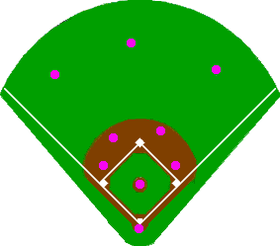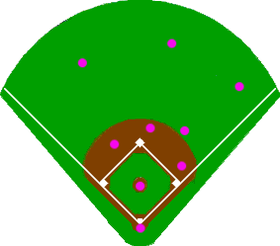Infield shift
The infield shift in baseball is a defensive realignment from the standard positions to blanket one side of the field or another. Used primarily against left-handed batters, it is designed to protect against base hits pulled hard into the gaps between the fielders on one side. Originally called the Williams shift, it has periodically been referred to as the Boudreau shift or Ortiz shift since then.


History
The infield shift strategy is often associated with Ted Williams, but it was actually first employed against Cy Williams during the 1920s.[1][2] Cy Williams, a left-handed outfielder with the Chicago Cubs (1912–1917) and Philadelphia Phillies (1918–1930), was second only to Babe Ruth in major league career home runs from 1923 to 1928. Opposing defenses would shift "practically to the entire right side" when he batted.[3]
The shift was later used against Ted Williams of the Boston Red Sox during the 1946 World Series, as a defensive gimmick by St. Louis Cardinals manager Eddie Dyer to psych out and hopefully contain the Boston slugger. It was devised by Cleveland Indians manager Lou Boudreau between games of a doubleheader in July 1946 to halt Williams' hot hitting.[lower-alpha 1] In his book Player-Manager, Boudreau wrote, "I have always regarded the Boudreau Shift as a psychological, rather than a tactical, victory."[4]:77
The shift has subsequently been employed to thwart extreme pull hitters (mostly lefties), such as Barry Bonds, Ryan Howard, Jason Giambi, David Ortiz, and Mark Teixeira.[7][8]
Implementing the shift
Typically the third baseman moves to the left where the shortstop plays; the shortstop plays to the right of second; the second baseman plays between first and second and usually on the right field grass; the center fielder plays right-center; and the first baseman and right fielder hug the foul line. Sometimes the third baseman, rather than the shortstop, will play to the right of second, allowing the shortstop (usually the team's best infielder) to remain near their usual position. While this is the most common type of defensive shift seen in baseball, there are numerous variations that can be implemented according to the hitting ability of the batter. For example, an effective defensive shift against Joe Mauer would have the infield shifted for a pull-happy left hander, and the outfield shifted for a pull-happy right-hander, due to Mauer's tendency to pull nearly all of his groundballs, and hit nearly all of his flyballs to the opposite field.[9]
Ortiz shift
The Ortiz shift consists of a baseball infield defense, however the shortstop and second baseman move to the outfield between first and second base while the left and center fielder are moved towards the right side of the field with the third baseman going to the left side of the outfield.[10]
Joe Maddon, as manager of the Tampa Bay Devil Rays, had an upcoming series against the Boston Red Sox in 2006 and was considering a strategy on how to defend against left-handed designated hitter David Ortiz.[10] Maddon was cycling on an exercise bike as he looked at Ortiz's sabermetrics and noticed that Ortiz mostly hit to right field and the majority of those hits landed in the outfield. Maddon created the Ortiz Shift to counter it.[10][11] The shift was first used in the Devil Rays' 7–4 loss to the Red Sox on 18 April 2006 at Fenway Park.[11] Though Ortiz was 2-for-5 in that game,[12] the tactic was successful and a number of other clubs employed it against Ortiz, with his batting average dropping from .300 over 2004–2006 to .265 midway through the 2006 season.[10]
Baseball historian Bill James—who worked for the Red Sox at the time—criticized the Ortiz shift as only working for ground balls and not for home runs, which he described as Ortiz's true danger.[13] Though the shift was mostly used against Ortiz, it has been used elsewhere in baseball.[14]
Defensive vulnerability
As the infield shift leaves some areas less covered than others, the batter who hits toward those areas may obtain better results than against an un-shifted infield. A stark example occurred in a 1970 game between the Philadelphia Phillies and the San Francisco Giants: Giant Willie McCovey bunted hard down the third base line when the shift was on. With no one covering third, Willie Mays, on first at the time, came all the way around to score, while McCovey reached second for a double.[15][16]
Infield shifts can also provide base running opportunities to the batting team. A notable example occurred in Game 4 of the 2009 World Series: with switch hitter Mark Teixeira of the New York Yankees batting left-handed, and the Philadelphia Phillies implementing an infield shift, baserunner Johnny Damon stole second base and then continued on to third base in one continuous play, as there was no fielder on the left side of the infield.[17] Damon would later score what proved to be the winning run of the game.[18]
Counter
The shift can be countered by the batter bunting towards third base, as the third baseman is positioned in the outfield.[19] For example, Ortiz started to hit more balls towards the left side of the field, taking advantage of the lack of position players in left field.[20] It was stated that a 2015 Major League Baseball proposal to ban defensive shifts would have benefited Ortiz.[20]
Anti-shift sentiment
As early as 2015, the Commissioner of Baseball considered banning the shift, with some MLB managers expressing agreement, although there is no consensus on such an idea.[21] In 2019, the independent Atlantic League of Professional Baseball, as part of an agreement with MLB to test experimental rules, has banned the shift by requiring two infielders to be positioned on either side of second base.[22]
See also
Notes
- Boudreau writes that Williams had three home runs in the first game of the doubleheader,[4]:76 which corresponds to July 14, 1946, as Williams was 4-for-5 with three home runs in the first game of a doubleheader between Boston and Cleveland that day.[5] Boudreau does not mention that even with the shift, Williams was 1-for-2 with two walks in the second game of the doubleheader.[5] Contemporary reporting also notes that Boudreau actually employed shifts against Williams in both games of the doubleheader, with the shift in the second game being more radical.[6]
References
- Vass, George (August 1999). 20th Century All-Overlooked Stars. Baseball Digest. Books.Google.com. Retrieved 24 April 2012.
- Vass, George (July 2004). Baseball's Forgotten Stars. Baseball Digest. Books.Google.com. Retrieved 24 April 2012.
- "(untitled)", The Constitution, Atlanta, p. 18, June 19, 1927, retrieved June 27, 2019 – via newspapers.com
- Boudreau, Lou (1949). Player-Manager. with Ed Fitzgerald. Boston: Little, Brown and Company. ISBN 1125962402.
- "The 1946 BOS A Regular Season Batting Log for Ted Williams". Retrosheet. Retrieved June 27, 2019.
- Birtwell, Roger (July 15, 1946). "Boudreau Tried Everything, but Nothing Seemed to Work". The Boston Globe. p. 6. Retrieved June 27, 2019 – via newspapers.com.
- Arthur, Rob (June 6, 2017). "Ryan Howard's Career Is Dead. The Shift Killed It". FiveThirtyEight.
- Paine, Neil (October 13, 2016). "Why Baseball Revived A 60-Year-Old Strategy Designed To Stop Ted Williams". FiveThirtyEight.
- "Mauer's Splits | FanGraphs Baseball". Fangraphs.com. 2010-02-08. Retrieved 2012-10-16.
- Chen, Albert (2006-06-19). "The Ortiz Shift". Sports Illustrated. Retrieved 2018-05-16.
- "Boston Red Sox – Game shifted into the bizarre". Boston Globe. 2006-04-19. Retrieved 2018-05-16.
- "Box Score of Game played on Tuesday, April 18, 2006 at Fenway Park". Baseball Almanac. 2006-04-18. Retrieved 2018-05-16.
- "Q & A: Baseball Guru Bill James". Time. 2008-03-06. Retrieved 2018-05-16.
- Richard, Mike. "The Sporting Goods: Pursuit of pitching perfection". Barnstable Patriot. Retrieved 2018-05-16.
- Neyer, Rob (2008). Rob Neyer's Big Book of Baseball Legends: The Truth, the Lies, and Everything Else. Touchstone. p. 140. ISBN 978-0743284905.
- "Philadelphia Phillies 13, San Francisco Giants 6 (2)". Retrosheet. May 3, 1970.
On a bunt McCovey doubled to left [Mays scored]
- "2009 WS Gm 4: Damon singles, then steals two bases". MLB. Retrieved June 27, 2019 – via YouTube.
- "New York Yankees 7, Philadelphia Phillies 4". Retrosheet. November 1, 2009. Retrieved June 27, 2019.
Johnny Damon stole 2B and no one covered 3B because of big shift in the infield, so Damon continued to 3B for a second steal on the same play
- "Boston Red Sox – Yanked out of first". Boston Globe. 2005-09-29. Retrieved 2018-05-16.
- "Boston Red Sox DH David Ortiz could benefit from elimination of defensive shifts". MassLive. 2015-01-26. Retrieved 2018-05-16.
- Baccellieri, Emma (July 25, 2018). "Proposing a Shift Ban Is Easy, but How Would MLB Implement One?". Sports Illustrated. Retrieved March 11, 2019.
- Jung, Tristan (March 8, 2019). "MLB's Experimental Rule Changes for 2019 Atlantic League Include Moving Mound Back, Banning Shifts". Sports Illustrated. Retrieved March 11, 2019.
Further reading
- Fink, Devan (April 29, 2019). "The Atlantic League Utilizes the No-Shift Rule for the First Time". Fangraphs. Retrieved June 28, 2019.
- Waldstein, David (12 May 2014). "Who's on Third? In Baseball's Shifting Defenses, Maybe Nobody". The New York Times. Retrieved 13 May 2014.
- "The Shift: Redesigning Baseball's Defense". 99% Invisible. November 1, 2016. Retrieved August 6, 2019.